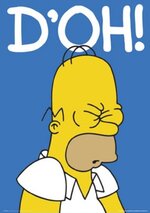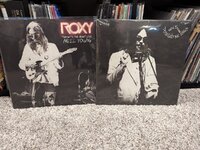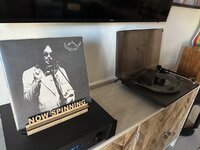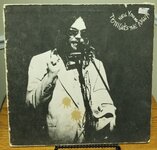Here's a compilation review. Definitely a heavy album!
The opening title track starts with the saddest piano notes you’ve ever heard, droplets of sorrow falling onto a lake of melancholy, and you quickly start to realise that this isn’t the same
Neil Young that sent endless numbers of music fans to sleep with the bland
Harvest, this is a
Neil Young dealing with personal loss and mourning. You don’t have to be told that the majority of
Tonight’s the Night was recorded during a wake (26 August 1973 apparently), somehow you just know. The deaths of Bruce Berry and
Danny Whitten had obviously hit Young hard, and there really was nothing for it but to get loaded with friends and try to record an album that was at different points performed in deep despair, during moments of drunken revelry, and when the whole band were impaired by various substances they hoped would ease the pain of the passing of their friends.
You should never, ever reach for
Tonight’s the Night when you need an album to cheer you up, and equally you should never reach for it during moments of severe despair, as it may very well convince you that life is just too much hard work. There’s a time and a place for
Tonight’s the Night, which inevitably means that you don’t play it very often, but it always, and I mean always, makes an impact when it is played.
The circumstances in which
Tonight’s the Night was recorded means that most of the songs here sound as if they are going to unravel at any moment due to the fact that Young, the remnants of
Crazy Horse and everyone else involved in the creation of the album were on the point of collapse.
Tonight’s the Night is an album of interesting juxtapositions as well, the best being the end of the cracked, broken and utterly fragile “Borrowed Tune” being utterly blown away the next moment by the live track “Come On Baby Let’s Go Downtown”, when Young and Whitten’s interlocking guitars and vocals blast joyously from the speakers. It’s the single moment of levity and celebration in an album based in misery and as such is a shining highlight of the album. It’s no accident that it is Whitten taking lead vocals on that one.
For an album recorded in such a shambolic state, there are some surprisingly strong numbers on
Tonight’s the Night, with “World On A String”, “Mellow My Mind” and “Tired Eyes” being some of Young’s best songs from this prolific period and “Roll Another Number (For The Road)” being a fine hymn to gentle excess.
Okay so
Tonight’s the Night is not an album you’re going to play very often, but it’s one that you savour every time you do, as you never know if it may collapse inwardly in on itself at any moment. No wonder that it took two years to release it.
Neil Young's 1975 "Tonight's The Night" is considered to be his 'darkest' album - both literally and figuratively - and the last of the "Ditch Trilogy" (along with Times Fade Away and On The Beach). The album explores the depth of Neil's pain over the heroin overdose deaths of Crazy Horse's Danny Whitten and roadie Bruce Berry. Although released in 1975, the album was actually recorded in 1973 after the disastrous Times Fade Away tour. Chronologically, "Tonight's The Night" is actually the second of the "Ditch Trilogy" albums. The darkness of the songs even continues to the album packaging with it's black & white cover and liner notes and black label instead of the normal orange reprise records label.
The bookends of Tonight's The Night are the title track which opens acoustic and concludes electrically. This unplugged and plugged approach which Neil pioneered in 1973 was continued again later with the acoustic "My My, Hey Hey (Out of the Blue)" and electric "Hey Hey, My My (Into the Black)" on 1979's Rust Never Sleeps and again on 1989's Freedom's "Rockin In The Free World" acoustic and electric version. The unplugged theme would later become a phenomenon in the 1990's with MTV's Unplugged series. One of the most revealing parts of the album is the liner notes themselves which are in Dutch. For most, the clues in Dutch were a mystery for most. Thankfully, a translation has been done which reveals some insights into Neil's despair during the period. It certainly reveals the importance of tequila and understanding the meaning of Tonight's The Night. From the liner notes: "The death of Neil's discovery and friend, Danny Whitten seems to have affected him deeply. Since 'The Needle & the Damage Done' most of Neil's songs about Danny's death reflect his guilt complex. Neil seemed to fall back into an even deeper depression. Then he began drinking, became sentimental and generally intolerable for anyone who had anything to do with him. It's said that those around him treated him with great caution for fear of provoking him, causing him to retreat and become a recluse. During this evening at the Rainbow, Neil makes particular reference to Miami Beach where he was safe from external influences and where a highly emotional and introverted process went its course."
Another fascinating aspect to the original vinyl album was the writing in the run out groove. On Side A the phrase "Hello Waterface" was written. And on Side B the phrase "Goodbye Waterface". There's been a great deal of speculation and rumor about what these cryptic phrases might mean. One theory is that it refers to either Danny Whitten or Bruce Berry. If this is the case, "Waterface" most likely refers to Whitten. Whitten has been described as an emotional person who was prone to bursts of sobbing. Hence, Danny's crying might be the "Waterface". The liner notes refer to "BB", which is clearly Bruce Berry. The note includes the line "Tell Waterface to put it in his lung and not in his vein." This line is an anti-heroin reference and speaks to Neil's loss of Crazy Horse bandmate Danny Whitten and long time roadie Bruce Berry's heroin overdose deaths.
Tonight's the Night is a direct expression of grief. Crazy Horse guitarist Danny Whitten and Young's friend and roadie Bruce Berry had both died of drug overdoses in the months before the songs were written. The title track mentions Berry by name, while Whitten's guitar and vocal work highlight "Come on Baby Let's Go Downtown"; the latter was recorded live in 1970. The song would later appear, unedited, on a live album from the same concerts, Live at the Fillmore East, with Whitten credited as the sole author.
Both a tribute to and a commentary on the drug overdose death of Crazy Horse guitarist Danny Whitten, Tonight’s The Night features an impressive cast of supporting players. Guitarist Nils Lofgren guests on eight tracks, including the title track. Legendary keyboardist/producer Jack Nitzsche plays piano on “Come On Baby Let’s Go Downtown,” a concert showstopper captured live at the Fillmore East. The album also features steel guitarist Ben Keith and Crazy Horse regulars Billy Talbot (bass) and Ralph Molina (drums).
Also, Pitchfork did a great review of this one as well. 10/10.
Neil Young: Tonight's the Night





